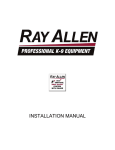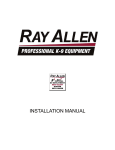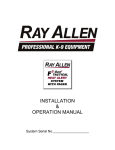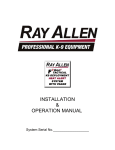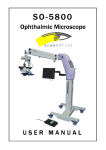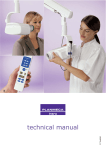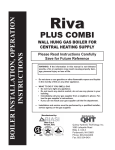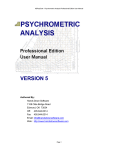Download INSTALLATION MANUAL - Ray Allen Manufacturing
Transcript
INSTALLATION MANUAL READ THIS FIRST Installation of this System should be carried out by qualified persons familiar with the general installation of law enforcement electronics commonly installed on police service vehicles. It is recommended that the installer(s) have updated wiring diagrams and schematics of the specific vehicle in which the System will be installed or have access to wiring information through a local dealership or other source. If you are replacing an existing deployment and/or heat alert system, remove all previous wiring before beginning installation. Our System requires that wiring connections be made as described in this manual - do not connect this to any other system’s pre-existing wires. Before installation: 1. Confirm all parts and components are included and accounted for by doing a complete inventory of the package contents. 2. Read this manual to familiarize yourself with the system’s unique requirements for installation. 3. Observe all safety practices. It is the installer’s responsibility to determine, implement, and observe those safety practices. Please note: This system is designed to be directly hardwired to the vehicle’s 12-volt battery. DO NOT CONNECT THE SYSTEM TO THE VEHICLE BATTERY UNTIL ALL CONNECTIONS HAVE BEEN COMPLETED AND VERIFIED AS BEING CORRECT. Do not connect this product to any device intended to detect vehicle battery drain. DOING SO MAY “POWER DOWN” THIS PRODUCT AND/OR RENDER IT INEFFECTIVE FOR ITS INTENDED USE. We recommend that you meet with the intended user to discuss preferences and installation requirements specific to the system’s application and user comfort. 1 RAY ALLEN F3 Series System™ Inventory Antenna w/15’ of cable Heads-Up Display (HUD) HUD Articulating Mount w/Hardware Pack (4 screws/nuts) Interactive Intelligent Remote Control/Pager Unit Remote Control Holster Remote Charger HUD/Remote Charging Pigtail System Control POD Stainless Steel Gas Push Rod Stainless Steel Push Rod Brackets Stainless Steel Hardware Pack (For Push Rod Brackets) 40 lb. 12-Volt Solenoid Control POD/HUD Communications Cable (Grey) Temperature Sensor w/15’ cable (Grey w/Black Tip) Electrical Hardware Pack POD & HUD Attachment Hardware Pack (8 self-tapping screws) Power-In Wire Harness Power-Out Wire Harness Qty 1 Qty 1 Qty 1 Qty 1 Qty 2 Qty 1 Qty 1 Qty 1 Qty 1 Qty 2 Qty 1 Qty 1 Qty 1 Qty 2 Qty 1 Qty 1 Qty 1 Qty 1 Installation Manual User’s Manual (To Remain in Car) Qty 1 Qty 1 2 Charging the Remote Control/Pager After unpacking the System we recommend that you immediately charge the Remote Control/Pager. To do this: 1. Locate the Remote Control and Remote Control Charger. 2. Plug Plug the Remote Control Charger into a 110v 60hz receptacle (standard wall plug). 3. Plug the Remote Control Charger into the charging port on the side of the Remote Control. 4. The message CHARGING BATTERY will appear on the LCD screen of the Remote Control/Pager along with a charging progress meter. NOTE: IF THE REMOTE CONTROL BATTERY IS COMPLETELY DEAD IT MAY TAKE A FEW MINUTES BEFORE THE CHARGING SEQUENCE BEGINS. NOTE: WE HAVE PROVIDED YOU WITH A LONG-LIFE REMOTE CONTROL BATTERY. DEPENDING ON TEMPERATURE, IT CAN TAKE OVER 2 HOURS TO FULLY CHARGE THIS DEVICE. FOR YOUR CONVENIENCE, THE REMOTE CONTROL/PAGER IS PROTECTED BY OVER-CHARGE CIRCUITRY THEREFORE IT CAN REMAIN ON THE CHARGER FOR LONG PERIODS OF TIME WITHOUT FEAR OF BATTERY DAMAGE. 3 Placement of RAY ALLEN F3 Series System™ Control POD Before starting your installation, consider the most appropriate placement of the system’s Control POD in the interior of the vehicle (the POD design requires that it be located inside of the passenger compartment). Be certain that: 1. Both wire harnesses can easily reach the Control POD as well as their intended point of connection to the vehicle components. 2. The antenna can be attached to the back of the interior rear view mirror and still make connection to the Control POD. 3. The Control POD/HUD Communications Cable can be routed from the Heads-Up Display to the Control POD. 4. The Control POD can be securely attached anywhere in the interior of the vehicle (it does NOT need to be grounded). Use the self-tapping screws included to secure the POD to the front panel of your K-9 insert or attach using 2-sided tape, Velcro® or any other attachment method you choose. All wire harnesses as well as the system antenna are provided with fifteen (15) feet of wire. The POD/HUD Communications Cable is ten (10) feet long. NOTE: TAKE CARE TO ROUTE ALL WIRES AWAY FROM EXCESSIVE HEAT SOURCES OR POINTS OF POSSIBLE ABRASION. 4 System Specification & Features Following are the system input and output descriptions and specifications. Due to the wide variety of vehicles in which this system could be used it is not possible to accurately describe all vehicle connections. Therefore it is up to the installer of this system to correctly locate, connect, and test each connection prior to final power connection and operational testing. Features • Reverse battery protection up to 100V • Load-dump protection up to 100V • Software over-current protection on all I/O and power outputs • ±0.5% temperature accuracy • Frequency hopping spread-spectrum wireless communication with Belt Mounted Remote Control/Pager • Noise immune RS485 communication with Heads-Up Display (HUD) • Fan output — off setting and 3 selectable speeds • Redundant hardware and software function to disable remote activated Tactical K-9 Deployment System™ when vehicle is in gear • 100% Solid State Design — no external relays required 5 Electrical Specifications Input Voltage Max Continuous Output Current (signal outputs) 6V – 15V 15A System Power Wire Harness • • • • System Power Input (RED) - To be connected directly to vehicle 12-volt battery positive terminal Door Solenoid Output – 30A max continuous (ORANGE) Fan Output – 15A max continuous (BLUE) System Ground (GREEN) - To be connected directly to vehicle 12-volt battery negative terminal Control POD/HUD Communications Cable • A four conductor CAT3 cable terminated on both ends with an RJ9 crimp plug Antenna • • • Omni directional Part 15 compliant 15 feet of cable 6 System Power-Out Wire Harness Pin # Wire Color Signal Name Left Window Output 1 Purple 2 Green - Black Stripe Neutral Safety Switch Input Signal Description This signal is connected to the window motor POWER-IN. It supplies an active +12V 15A output signal when the system is rolling down the window. It also acts as a circuit pass-through path when the window is manually controlled. This signal input is connected to the vehicle neutral safety wire. Signal should be high resistance when the vehicle is in gear and low resistance when the vehicle is in park or neutral. To bypass this feature, attach wire to ground. 3 N/A N/A N/A 4 Yellow* Horn Output This output is connected to the vehicle horn or other audible alert device. It supplies a pulsed (1 second on, 1 second off) 12V 15A output 30 seconds after an unacknowledged alert is triggered. 5 Grey Aux Output Inactive — for future use. 6 Orange Door Unlock Output This signal is connected to the door lock/unlock solenoid inside the door. It supplies an active +12V 15A output signal when the system is unlocking the door to be opened. It also acts as a circuit pass-through path when the door lock is manually controlled. 7 Blue Right Window Output This signal is connected to the window motor POWER-IN. It supplies an active +12V 15A output signal when the system is rolling down the window. It also acts as a circuit pass-through path when the window is manually controlled. 8 Purple – Black Stripe Left Window Pass-Through This signal is connected to the window control switch side of the wire used for Pin #1 in the door. It acts as a circuit pass-through path when the window is manually controlled. This wire is not required for Ford product installations. 9 Grey – Black Stripe Aux Input Inactive — for future use. 10 N/A N/A N/A 11 N/A N/A N/A 12 White* Lights Output This output is connected to the vehicle lights (parking lights recommended) or other visual alert device. It supplies a pulsed (1 second on, 1 second off) 12V 15A output 30 seconds after an unacknowledged alert is triggered. 13 Orange – Black Door Unlock Pass-Through Stripe 14 Blue – Black Stripe Right Window PassThrough This wire is connected to the door lock control switch side of the wire used for Pin #6 in the door. It acts as a circuit pass-through path when the door lock is manually controlled. This signal is connected to the window control switch side of the wire used for Pin #7 in the door. It acts as a circuit pass-through path when the window is manually controlled. This wire is not required for Ford product installations. * 150˚C temperature wire Output Pin Numbering Diagram 14 13 12 11 10 9 7 6 5 4 3 2 8 1 Viewed from wire side 7 Window Lowering Feature Installation For installation into a Ford Product, disregard this page and use separate instruction sheet for relay installation included with System. The wiring harness included with this system has two (2) wires designated for this feature for each side window. These wires should be routed from the ‘B’ pillar through the conduit to each door. Do not connect these wires at the driver’s side door switch – make the connection inside each door. To determine the wire in the door used to activate this feature, re-connect the window power switch to the wire harness in the door. Activate the window switch from the driver’s door and using a volt-meter, determine the wire that changes from 0 to 12 volts during the lowering of the window. Cut this wire and connect the Window Output wires as listed in the chart above (purple for left / blue for right) to the motor side of this wire. Connect the Window Pass-Through wires listed in the chart above (purple w/black stripe for left / blue w/black stripe for right) to the switch side of this wire. Butt-splices are included for these connections. Push switch back through hole and attach to inside of door as noted below. NOTE: AFTER CONNECTING THE WIRE HARNESSES TO THE CONTROL POD, BE SURE TO TEST THE WINDOWS FROM THE DRIVER’S CONTROL TO INSURE WIRES ARE PROPERLY ATTACHED. FINALIZE CONNECTIONS AND SECURE THE WINDOW SWITCH AND THE WIRES TO THE INSIDE OF THE DOOR WITH THE ENCLOSED ZIP-TIES (WE SUGGEST REMOVING ANY STOCK MOLDING FROM THE SWITCH). INSURE THE WIRES AND THE SWITCH DO NOT INTERFERE WITH THE WINDOW TRACK OR ANY LINKAGE IN THE DOOR AND THAT THE DOOR PANEL OF THE VEHICLE K-9 INSERT CAN BE ATTACHED. 8 Door Unlatch Solenoid Installation We have included a heavy duty door unlatch solenoid that will give years of trouble free use. Follow the manufacturer’s recommendations for installing the door unlatch solenoid. Be sure to align the solenoid so that the pull/throw of the piston is in a straight line with the motion of the door unlatch mechanism. Also, be sure to avoid any part of the window track or the linkage used in raising and lowering the window. NOTE: CABLE NEEDS TO BE ADJUSTED SO THAT DOOR LATCH IS FULLY ACTUATED WHEN SOLENOID IS COMPRESSED. NOTE: BE CERTAIN TO PROPERLY GROUND THE SOLENOID. THE DOOR MAY NOT BE A GOOD GROUND. CONSIDER ROUTING A SEPARATE WIRE FROM THE SOLENOID GROUND WIRE AND ATTACHING IT DIRECTLY TO THE VEHICLE CHASSIS OR BODY. NOTE: THE ABOVE MOUNTING LOCATION IS ONLY A SUGGESTION FOR PLACEMENT ON A NEWERMODEL CROWN VIC. WE DO RECOMMEND THAT ON A DODGE MAGNUM OR A CHARGER YOU LOCATE THE SOLENOID DIRECTLY ABOVE THE MID-DOOR BRACKET AND THE WINDOW MOTOR ON A HORZONTAL STRAIGHT LINE WITH THE DOOR LOCK. THE RAY ALLEN CRUISE EZE™ DOOR PANELS ALLOW ENOUGH ROOM FOR THE INSTALATION OF THIS SOLENOID IN THAT LOCATION. 9 Door Unlock Solenoid Connection The wiring harness included with this system has two (2) wires designated for this feature. These wires should be routed from the ‘B’ pillar through the conduit to the same door to which the door unlatch solenoid is installed. To determine the wire in the door used to activate this feature, locate the stock unlock solenoid located in the door and trace the wires to an accessible point within the door. Activate the door unlock feature from the driver’s door. Using a volt-meter, determine the wire that changes from 0 to 12 volts during unlocking. Cut this wire and connect the Door Unlock Output wire as listed in the chart above (orange) to the solenoid side of this wire. Connect the Door Unlock PassThrough wire listed in the chart above (orange w/black stripe) to the other side of this wire. Butt-splices are included for these connections. NOTE: BEFORE FINALIZING THESE CONNECTIONS, BE SURE TO TEST THE DOOR UNLOCK FEATURE FROM THE DRIVER’S CONTROL TO INSURE WIRES ARE PROPERLY ATTACHED. FINALIZE CONNECTIONS AND SECURE THE WIRES TO THE DOOR WITH THE ENCLOSED ZIP-TIES. INSURE THE WIRES DO NOT INTERFERE WITH THE WINDOW TRACK OR ANY LINKAGE IN THE DOOR. NOTE: PLEASE BE SURE THAT YOU UNDERSTAND THE TERMINOLOGY BEING USED HERE. THE UNLATCH SOLENOID IS THE SOLENOID THAT PHYSICALLY ACTUATES THE DOOR HANDLE. THIS SYSTEM PROVIDES THIS HEAVY-DUTY SOLENOID FOR THIS PURPOSE. THE UNLOCK SOLENOID IS A STOCK PART ON ALL VEHICLES WITH ELECTRIC DOOR LOCKS – SUCH VEHICLES COME WITH AN UNLOCK SOLENOID IN EACH DOOR AS STANDARD EQUIPMENT. 10 Stainless Steel Gas Push Rod Installation The stainless steel gas push rod should be mounted to the same door to which the door unlatch solenoid is installed. We have included a variety of stainless steel hardware to mount the push rod. Be sure the push rod is mounted so it can push the door as far open as possible but also allow the door to be closed completely. We recommend that the push rod be installed on a very slight downward angle (from cylinder to rod) so that proper lubrication of the pressure seal can take place. NOTE: LOCATE THE PUSH ROD SO THAT IT IS NOT IN A DANGEROUS POSITION FOR THE K9’S ENTRANCE AND EXIT OF THE VEHICLE. THE PHOTO ABOVE SHOWS A SUGGESTED LOCATION FOR MOUNTING THE GAS PUSH ROD. 11 Antenna Attachment The system antenna should be mounted in a vertical configuration to the back (vehicle front) of the driver’s internal rear view mirror. Be careful to route the wire in such a manner as to insure that the wire will not interfere with the occupants of the front seat. The cable for this antenna is fifteen (15) feet long. NOTE: THIS ANTENNA REQUIRES “LINE-OF-SITE” ACCESS TO THE WINDSHIELD AND SHOULD NOT BE BLOCKED. DOING SO WILL REDUCE THE EFFECTIVE RANGE OF THIS DEVICE 12 Temperature Sensor Placement You have been provided with two (2) Temperature Sensors which are specifically designed to work with this system. Each Sensor has fifteen (15) feet of cable. These Sensors are plugged into the system Control POD (the two plugs next to the antenna port – opposite side of the wiring harnesses). Care should be taken before deciding where their final mounting point should be. We have provided hook and loop fasteners (Velcro®) to secure these Sensors. Place the cable under the Velcro® so that the black Temperature Sensor is completely exposed. Consider: 1. Neither Sensor should be mounted in a position that is subject to direct sunlight nor in close proximity to air conditioning vents — doing so will give incorrect readings of the “true” temperature inside the vehicle. 2. Cables should be routed to avoid points of possible abrasion. 3. Be certain the K9 cannot get to the sensors or their cabling as neither are chew proof! 4. DO NOT plug in the sensors to the Control POD at this time. Attaching the sensors to the POD will be the one of the last steps in the installation as these sensors need to be configured by the System when it is powered. Insure that there is enough wire to allow the sensors to be plugged in, but leave them unplugged for now. 13 Neutral Safety Switch Connection If you are installing this unit into a 2003 or newer Tahoe or Yukon, please see separate instructions with the wire included with your System and disregard the first paragraph below. To properly activate this feature, the system looks for an open circuit to disable the Tactical K9 Deployment System™. Under the dash or somewhere else within the vehicle, locate the wire that reads 0 – 200 Ω (OHMS) when the vehicle is in Park or Neutral and 1000 Ω (OHMS) or higher (or a completely open circuit) when in gear. Carefully splice the green w/black stripe system wire into this circuit. You can bypass this feature by attaching this wire to a ground. This will allow the Tactical K9 Deployment System™ to operate at ALL TIMES – whether the vehicle is in gear or not. Some handlers request Neutral Safety to be disabled so that option is available to you. Lights and Horn Connection (optional) Under the dashboard, at the fuse panel or under the hood of the vehicle, locate the wires used for these features. Activate the lights and the horn from inside of the vehicle. Using a volt-meter, determine the wire that changes from 0 to 12 volts when these features are activated. Carefully splice into this circuit. On certain vehicles it may be necessary to splice into the wiring circuit beyond relays and fuse boxes. The key is to find the wire that changes to 12 volts when the feature is activated. MD10 F Ray Allen Fan Connection (optional) The Ray Allen MD10 F Fan is designed to bolt directly to either side of the front panel on the Ray Allen Cruise Eze™. Hardware for this installation is included with the Fan. When attaching the Fan to the front panel of your Cruise Eze™, we suggest you insert the bolts and washers from inside of the cage and place the nut on the Fan side. You do not want the nut on the inside of the cage as it has a higher profile than the bolt head and this may injure the dog. Also included is the wiring to connect directly to the system’s Control POD. To complete this connection, attach the fan wire from the Control POD (blue wire of the System Power Wire Harness) to the blue wire on the fan (butt-splices are included for this connection). Connect the black fan wire to a good body ground. Test this connection when testing the complete system. This fan is designed to blow “in” to the Cruise Eze™ unit. If for some reason you wish this fan to blow in the opposite direction, simply reverse these wire connections. 14 Placement of Heads Up Display (HUD) The HUD is the user’s window into the system for information read-outs and feature programming therefore easy access to the HUD visually and physically is vital. We have included an articulating mount that can be used for this purpose. This mount easily attaches to the HUD using the self-tapping screws included in your hardware pack. Once the location has been determined (we recommend the intended user be involved in this decision) the base of the mount can be permanently attached to the vehicle utilizing the two-sided tape already on the base. This tape is extremely adhesive so you will only get one shot at this. If you wish to mount the HUD directly to the dashboard as shown below (photo on the right), either attach the HUD using the self-tapping screws or attach with Velcro® or two-sided tape. NOTE: TAKE CARE TO ROUTE THE COMMUNICATION CABLE AWAY FROM EXCESSIVE HEAT SOURCES OR POINTS OF POSSIBLE ABRASION. Suggested locations for the HUD: On top of dashboard. On facing of dashboard. NOTE: WE CANNOT STRESS STRONGLY ENOUGH THAT THE INTENDED USER BE INVOLVED IN THE DECISION ON THE LOCATION OF THE HUD UNIT. 15 Completing the Installation Insure that all connections are securely attached to the Control POD except for the temperature sensors. Confirm that the communications cable is plugged into the POD and the HUD. Verify that all wire splices and butt-connectors are secure and that there is no chance of a short circuit. Once all of the above is completed, connect the System’s Power and Ground cables to the vehicle battery’s positive and negative terminals. Power up the RAY ALLEN F3 Series System™ by pressing and holding down the center button on the front of the HUD. When the display appears, release the button. The HUD will run a self diagnostic routine. Upon completion of this routine proceed to the following steps. 16 Configuring the Temperature Sensors You are now ready to attach the temperature sensors. Enter the SETUP Menu by pressing the center button on the HUD one time (do not hold the button down). Use the up or down buttons to move the cursor to the ADVANCED option and then press and release the center button. Place the cursor on SET UP SENSORS, press & release the center button and then follow the instructions and respond to the prompts on the screen. The screen will instruct you to attached Sensor 1. We suggest that you attach the LEFT temperature sensor at this time (you can plug this into either of the receptacle plugs on the Control POD). This will allow the system to configure the LEFT sensor as Sensor 1 (Sensor 1 is on the left side of the LCD display hence the suggestion that the LEFT sensor be designated as Sensor 1). After the system recognizes Sensor 1, it will prompt you to respond on the HUD display (hit OK) and then ask you to unplug this sensor and plug in Sensor 2. Remove the LEFT sensor plug from the Control POD and plug the RIGHT sensor into the other receptacle plug on the POD (hit OK again). The system will very quickly recognize Sensor 2 and direct you to plug in both Sensors. Plug the LEFT sensor back into the POD and respond to the prompt on the HUD display to complete the installation. The temperature sensors are now configured. The System will automatically return to the ADVANCED Menu. NOTE: AT SOME POINT YOU SHOULD ATTACH THE CONTROL POD TO THE VEHICLE. IF YOU HAVE NOT DONE THIS YET, YOU CAN DO SO NOW OR AT THE COMPLETION OF THE SYSTEM TEST. 17 Calibrate the Remote Control/Pager You now must calibrate the remote to establish initial communication and to insure that the Control POD and the Remote Control/Pager are communicating in the most efficient manner. Before proceeding, insure that the Remote Control has been fully charged (see “Charging the Remote Control” on Page 3). Start this process on the HUD by selecting Calibrate Remote Control in the ADVANCED Menu. Turn on the Remote Control/Pager (RCP) by pressing and holding the right button below the LCD display (ON-OFF is molded into the RCP below this button). Once the display responds, release the right button, press and hold the left button, and then very quickly press and hold the right button again. When the RCP displays LOOKING FOR POD, POD SN and FREQ ADJUST on the screen, release both buttons. After a brief configuration routine as the RCP “finds” the Control POD (and the countdown completes), press and release the right button (ACCEPT) — the display will then show “Building Frequency Tables” and after a few moments the RCP will shut down automatically. On the HUD press the DONE button and then exit all menus by pressing and holding the center button (you’ll need to exit the ADVANCED Menu and then the SETUP Menu). When you have exited all menus, the HUD display should show temperatures in the Sensor 1 and Sensor 2 fields, and the D (on the left) and H (on the right) will appear dim with a circle w/line over each letter. Re-start the RCP by pressing and holding the right button until the display responds then release the button. After a configuration routine, the display will show temperature readings, the signal strength bar and battery condition bar. Shut down the HUD and the Remote Control/Pager and then restart both (HUD first) to finalize all configurations. NOTE: IT IS RECOMMENDED THAT THE SYSTEM BE FULLY TESTED BEFORE BEING PUT INTO SERVICE. INSURE THAT ALL CONNECTIONS HAVE BEEN CONFIRMED. CONTINUE ON TO THE TEST. You are now ready to test The RAY ALLEN F3 Series System™ 18 Testing the HEAT ALERT™ System For this test it is important that all vehicle windows are closed. Start the vehicle and power up the HUD and the Remote Control. Be sure the vehicle emissions are properly ventilated from the garage or that this test is conducted outside in a well ventilated area. Check that both the HUD and the Remote Control show “SYS OK”. Be sure that the fan is set to OFF (level 0). In the SETUP Menu, select HEAT ALERT, then set the system values as follows (refer to the Users Manual if necessary): HEAT ALERT “ON” TEMP MODE “F” ALERT TEMP “70” ALERT DELAY “01” WINDOW DROP “BOTH” ALERT MODES “BOTH” Exit the SETUP Menu. On the HUD display, insure that the H on the right side of the LCD is now bold without a circle w/line over it (if it is not bold, wait one minute for the Alert Delay to complete). If necessary, turn on the vehicle heater and adjust to high to raise the interior temperature of the vehicle as quickly as possible. When the interior of the vehicle reaches 70F and BOTH sensors indicate 70F, the following will happen: 1. The system will send a page to the Remote Control/Pager. 2. The windows that have been wired into the system will lower — if both windows are wired, the left window will lower first and then the right window. 3. After the windows have lowered, the system will turn on the fan at full speed (if the optional fan is installed). 4. The HUD will display ALERT! — HIGH TEMP ALERT. 19 The Remote Control will alert the user by: 1. Making alternate audible tone and vibrating sequences (if mute has been activated on the Remote Control, no audible tone will be heard). 2. The Remote Control’s LCD display will read ALERT! — HIGH TEMP ALERT. Approximately 30 seconds after a HEAT ALERT™ has activated, the vehicle’s horn (if integrated) will sound and the lights (if integrated) will flash. If both the horn and lights are connected and selected in the ALERT MODES menu, they will alternate (horn, lights, horn, lights, etc.) when activated. The HEAT ALERT™ can be reset by pressing the RESET button once on the Remote Control or the HUD. The fan will continue to run at high speed and the windows will remain down but the audible/vibration alert will delay for one (1) minute (the amount of time set as the ALERT DELAY) or until the interior of the vehicle has lowered to a temperature below the ALERT TEMP setting in the HEAT ALERT™ menu. NOTE: WHEN THIS TEST IS COMPLETED RESET THE ALERT TEMP TO 85F. SUCCESSFULLY, WE SUGGEST THAT YOU Now it is time to move on to the K9 Deployment test. 20 Testing the Tactical K9 Deployment System™ In the SETUP Menu select the DOOR OPENER option, then set the system values as follows (refer to the Users Manual if necessary): DOOR OPENER “ON” WINDOW DROP “BOTH” Exit the SETUP Menu. On the HUD display, insure that the D on the left side of the LCD is now bold without a circle w/line over it. Be sure the vehicle is parked far enough away from other vehicles so that when the Tactical K9 Deployment System™ is activated, the door being opened doesn’t impact anything. Insure that the vehicle is in Park or Neutral (if the Neutral Safety feature is enabled). Leave the door open but force the door latch shut with a screwdriver or similar instrument. Press the Deploy K-9 button located on the back of the Remote Control. The following will happen: 1. 2. 3. 4. The system will unlock the door. The system will then automatically activate the door unlatch solenoid. The door latch will open. The Remote will beep twice and vibrate once to acknowledge Deployment activation. 5. The windows that have been wired into the system will lower — if both windows are wired, the left window will lower first and then the right window 21 Perform this action several times to insure the door unlatch solenoid cable is properly adjusted. Now test the system by fully closing the door and performing the test again. If the installation was successful, the door will unlock & unlatch in less then one (1) second and the door will open smoothly without binding. For safety purposes and to be sure all solenoid connections are properly adjusted, it is advisable to test the system several times before completing the installation of the door panels and putting the unit into service. Do so by performing the above test several times from a variety of distances to gain confidence in the installation. Also, lower and raise the windows a few times to insure the wiring inside the door is clear of all moving parts. NOTE: IF THE NEUTRAL SAFETY SWITCH FEATURE IS BEING USED, THE DOOR UNLATCH SOLENOID WILL ONLY ACTIVATE IF THE VEHICLE SHIFT LEVER IS IN PARK OR NEUTRAL. TEST THIS FEATURE TO BE CERTAIN. IF THE DOOR UNLATCH SOLENOID ACTIVATES WHILE THE VEHICLE SHIFT LEVER IS IN ANY POSITION OTHER THAN PARK OR NEUTRAL, THE NEUTRAL SAFETY SWITCH WIRE FROM THE POD WAS NOT PROPERLY CONNECTED OR THE WRONG WIRE IN THE VEHICLE WAS USED. NOTE: ALSO, IF THE NEUTRAL SAFETY SWITCH FEATURE IS BEING USED, THE BOLD “D” ON THE LEFT SIDE OF THE HUD DISPLAY AND RCP WILL DIM AND HAVE A CIRCLE WITH A LINE THROUGH IT OVER IT WHEN THE VEHICLE IS PUT INTO GEAR. ON RETURN TO NEUTRAL OR PARK, THE “D” WILL BECOME BOLD AGAIN. NOTE: AFTER THE TEST IS COMPLETED SUCCESSFULLY, WE SUGGEST THATYOU RESET THE WINDOW DROP OPTION IN THE DOOR OPENER MENU TO “OFF”. 22 Confirm the Displays and That The System is Fully Operational Once the system is fully tested and operational, the HUD display will look similar to the photo below (with the actual temperature readings from your vehicle). Verify the following: The HUD shows two (2) Temperature Displays A bold “D” appears on the left side of the display A bold “H” appears on the right side of the display System Status is “SYS OK” Test the Backlight (BL) function (Do so by pushing the left button on the HUD. The LCD display should change according to the settings from 0 – 3 with 3 the brightest.) Test the Fan function (Do so by pushing the right button on the HUD. The fan must be connected to the Control POD and properly grounded in order to function.) 23 Confirm the Displays and That The System is Fully Operational (continued) Once the system is fully tested and operational, the Remote Control/Pager display will look similar to the photo below (with the actual temperature readings from your vehicle). Verify the Following: The Remote Control Makes Connection W/System The Remote Control Displays Two (2) Temperature Readings A bold “D” appears on the left side of the display A bold “H” appears on the right side of the display System Status is “SYS OK” Signal Strength Is Maximum (Left Vertical Bar) Battery Level Is Maximum (Right Vertical Bar) 24 Notifications From The Interactive Intelligent Remote/Pager Displayed Message Event Description Audible/Tactile Feedback The in-vehicle temperature has exceeded the alert temperature at both sensors. Continuous alternating vibrator and beeper (No beeper if ‘MUTE’ is enabled). The vehicle battery voltage has dropped below 12.2 volts. Continuous alternating vibrator and beeper (No beeper if ‘MUTE’ is enabled). The Remote Control battery needs to be recharged to ensure continued operation. Continuous vibrator cycles. LOW BATTERY The Remote Control has lost synchronization with the RF signal from the Control POD. No audible or tactile feedback. OUT OF RANGE ALERT! HIGH TEMP ALERT ALERT! VEHICLE POWER 25


























